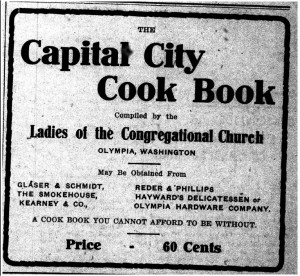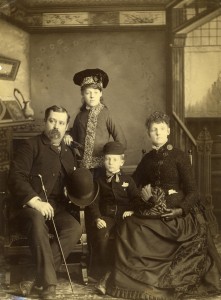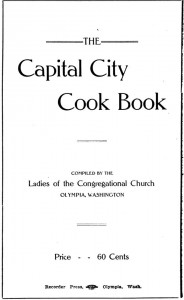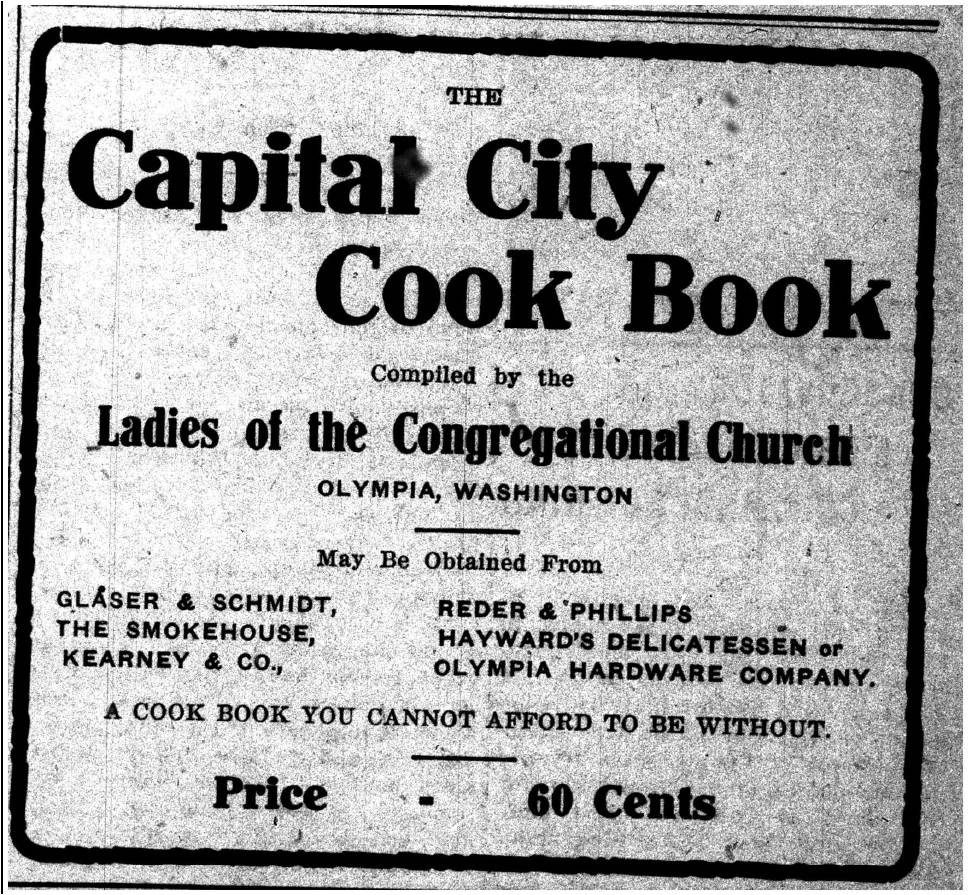Cooking is an important part of everyday life, a fact reflected in the many cookbooks published every year. Back in 1915, the “Ladies of the Congregational Church of Olympia” compiled a cookbook of recipes from women throughout the community. Entitled The Capital City Cook Book, this publication offers a rare glimpse into the daily lives of a large cross-section of Olympia women a hundred years ago. (The First Congregational Church merged with the First Presbyterian Church in 1916 to become the current United Churches.)
 Although it is not quite clear just when and why The Capital City Cook Book was put together, the publication was advertised as early as March 1915 in local newspapers. Further advertisements can be found in October and December of the same year, suggesting the books as potential Christmas presents. Sold for 60 cents (approximately $14 in 2015 dollars) the “Cook Book you cannot afford to be without” was available at various local shops, particularly stationary and grocery stores.
Although it is not quite clear just when and why The Capital City Cook Book was put together, the publication was advertised as early as March 1915 in local newspapers. Further advertisements can be found in October and December of the same year, suggesting the books as potential Christmas presents. Sold for 60 cents (approximately $14 in 2015 dollars) the “Cook Book you cannot afford to be without” was available at various local shops, particularly stationary and grocery stores.

The book contains over 600 recipes submitted by more than 220 individuals, along with excerpts from popular magazines such as “Good Housekeeping” and books such as “What to Eat” and “Clever Cooking.” Advertisements for products such as Kwikserv Hot Sauce and Royal Chef Pure Minced Razor Clams for Soup and Chowder also listed recipes. Swans Down Cake Flour even put in a full page of “How to Improve Your Cake”—using their flour of course. Buckeye Extracts, an Olympia company that produced flavoring extracts and medicinal supplies, sponsored the chapter “Small Cakes, Cookies, Doughnuts.” The book is also full of advertisements for local businesses, especially those connected to food.
The Capital City Cook Book is organized into twenty chapters: bread; breakfast and tea breads; cakes; small cakes, cookies, doughnuts; cake fillings; dainty deserts; pastry; fruit cupboard; candies; cheese; salads; meats; poultry; soups; sandwiches; Spanish dishes, eggs; pickles; vegetables; and miscellaneous. It even includes a section on household cleaning tips. The recipes, as demonstrated by chapter titles, are heavy on desserts. In fact, there are 116 recipes for cakes alone. This is because the publication was meant to be a special cookbook, with the women’s “best” and most treasured recipes.

Recipes in the book also represent the changing technology and customs of the time. Few women would have had electric or even gas stoves and ranges, so recipes do not list exact temperatures instead indicating “slow oven,” “moderate oven,” or “quick oven”—and rarely list approximate cooking times. Recipes also seldom list how much they produced, as an experienced cook should be able to estimate that. Ingredients are usually listed inside the recipes, not separately, with often vague measurements such as “butter the size of an egg,” teacups, coffee cups, etc. instead of standardized measuring cups.
The women who submitted recipes for The Capital City Cook Book are interesting. At thirty-seven recipes, the woman with the most entries is Minnie King Hildebrand, who contributed the entire seventeenth chapter, “Spanish Recipes.” These recipes are Americanized versions of Spanish and Mexican dishes. They include Chili Colorado and “Spanish” versions of scrambled eggs, tomato salad, string beans, soups and stews, etc. Hildebrand was active in woman’s organizations, such as the Women’s Educational Club and the Woman’s Relief Corps. Hundreds of other women contributed to the Cook Book. Ada Mowell, a prominent women’s leader, provided three recipes for white cake, fruit salad, and oysters and macaroni.
The Capital City Cook Book currently is located in a number of libraries around the country, mostly at universities. A digital copy is viewable on the Hathi Trust website. Locally, the Washington State Library retains a copy that was donated by Tate Henry Rogers (1884-1979). Her mother-in-law Parmelia Augusta (Moore) Rogers (1847-1924) contributed nine recipes to the book. These are brown bread, coffee fruit cake, jumbles, lemon sauce, chess cakes, sharp brown sauce, olive sauce, chili sauce, and spiced tomatoes.

Born in Seneca Falls, New York, Parmelia Augusta Moore married Adlebert DeLos (A. D.) Rogers (1844-1917) in 1868, who after moving to Olympia ran a prominent photography business for many years. She was active in women’s organizations and a member of the First Congregational Church. Perhaps it is a fitting tribute that a cookbook, which offers a window into the lives of numerous local women a hundred years ago, was donated to the Washington State Library by a close family member of someone who contributed much to the book and the community.
A sample recipe: Parmelia Augusta Rogers’s “Chess Cakes” (page 69):
Line patty pans with pie crust: 1 cup sugar, ½ cup butter, ¾ cup chopped raisins, ¾ cup chopped nuts, yolks of 3 eggs, whites of 2 for top—fill shell with filling.
Note for modern readers: The recipe leaves out a lot of steps. Be sure to cook thoroughly. Contains nuts. May omit nuts if desired. A patty pan can be replaced by a modern cupcake pan.




















































